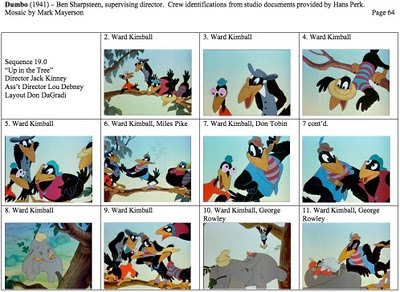Dumbo Part 23

While there are nice bits of animation in this sequence, this section is really dominated by story and layout. The way in which the audience learns that Dumbo can fly is quite inventive. Rather than see a take-off, the screen is obscured with dust, Timothy is convinced they've failed and then the audience sees Dumbo's shadow on the farmlands below. This image is one that could only exist in a period when commercial air travel existed or the audience (and the artists) could never have conceived of such a shot. The other great piece of layout is shot 28, where Dumbo lands on the phone wires. That's another shot that depends on the widespread use of a technology. Will future audiences understand what those wires are when all they know is cell phones? I'm assuming that Don Towsley animated the bending poles. It's a thankless task; what could be more boring? Yet the shot always gets a laugh. Towsley's Dumbo still has a pinched face, where the features are too



